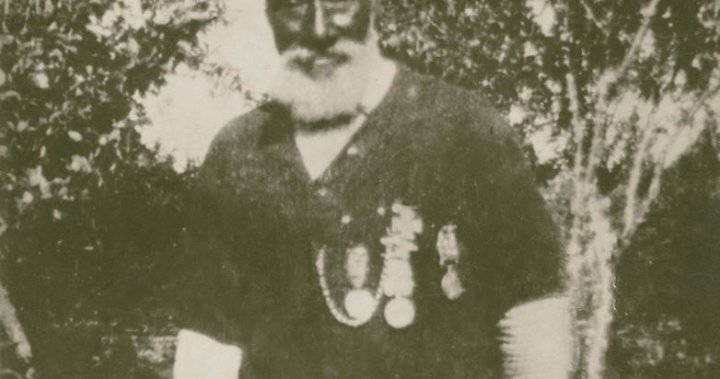Against a backdrop of unimaginable racism and hardship, William Hall’s courage on the battlefield in 1857 led him to become the first Black person awarded the Victoria Cross, Britain’s highest military decoration.
On Monday, Nova Scotia’s annual Heritage Day, the province will pay tribute to Hall, who was born in Horton’s Bluff, N.S., in April 1827.
“When we think of the narrative of William Hall, we have to think of the complexity of the Black community in Nova Scotia and the important role it has played on an international level,” said Russell Grosse, executive director of the Black Cultural Centre for Nova Scotia.
“This is a community that has overcome so much and has given back so much.”
Hall’s story starts with his parents, Jacob and Lucy Hall, both slaves from Maryland who fled to Halifax during the War of 1812. They were among successive waves of Black migrants who faced discrimination when seeking land grants and jobs. But their perseverance, like those before them, led to the creation of dozens of African Nova Scotian communities across the province.
As a boy, Hall worked in the shipbuilding trade in Hansport, N.S., but it wasn’t long before he was drawn to the sea. He later worked aboard merchant vessels that took him to ports around the world, and he later enlisted in the Royal Navy in 1852.
“In the mid-1800s, ideas about diversity and inclusion would have been very different from today,” Grosse said in a recent interview. “To be a Black man from Nova Scotia and to join the military at that time would have taken a lot (of courage).”
Hall served with distinction during the Crimean War, and in 1857 he sailed aboard HMS Shannon to India, where the British military was ordered to subdue rebel Indian soldiers who had laid siege to the British garrison in Lucknow.
Get the latest National news.
Sent to your email, every day.
The Indian Rebellion of 1857, as the conflict was known, was a campaign of resistance to the British East India Company, which at the time was an often abusive agent of British imperialism.
Hall, then a navy captain of the foretop, was among 400 sailors and marines who hauled some of the ship’s large guns more than 1,000 kilometres overland to Lucknow, where the rebels were entrenched in a large mosque.
Under heavy fire on Nov. 16, 1857, Hall was among naval crews that moved their guns close to the mosque in a bid to blast through its thick outer walls.
“After each round we ran our gun forward, until at last my gun’s crew were actually in danger of being hurt by splinters of brick and stone torn … from the walls we were bombarding,” Hall said afterwards.
But the daring move was a deadly gambit. Eventually, only Hall and one other sailor, Lt. Thomas James Young, were left firing their 24-pound gun.
“Most of the crew of their ship had perished and they were still under fire,” said Grosse. “He took a large canon — he and Thomas Young — and they were able to keep firing this canon to breach the walls.” The mosque was captured soon afterwards.
In October 1859, Hall was awarded the Victoria Cross in Ireland aboard his new ship, HMS Donegal. Young was also awarded a Victoria Cross.
Hall served on several other vessels until he retired from the Royal Navy as a petty officer first class in 1876 after 24 years of service.
“That in itself is remarkable — in those times of racial discrimination … that he could have navigated to have a long career,” said Grosse. “He must have been highly respected and very effective at what he did.”
Hall returned to Nova Scotia after retirement and settled near Avonport with his two sisters. He died in 1904.
Despite his battlefield heroics, William Neilson Edward Hall was buried without military honours.
But his legacy was not forgotten. In 1937, a local campaign was started to recognize Hall’s military accomplishments. Several years later, his remains were moved to a grave near the Hantsport Baptist Church, where a cairn was erected in his honour. The monument includes a replica of his Victoria Cross and a plaque describing his devotion to duty.
Other honours would follow.
In 2010, Canada Post issued a commemorative stamp. It features an illustration of an older man with a full, white beard and four medals on his blue jacket. In the background, HMS Shannon is sailing on a green sea.
In June 2015, the Royal Canadian Navy announced that its fourth Arctic and Offshore Patrol Ship would be named HMCS William Hall.
Today, Hall’s Victoria Cross is part of the Nova Scotia Museum’s heritage collection. Its simple inscription reads: “For valour.”
“We pay tribute to William Hall, a man whose resilience and bravery stand as a beacon for all Nova Scotians,” Twila Grosse, Nova Scotia’s minister of African Nova Scotian affairs, said in a statement. “His story is a powerful reminder of the contributions African Nova Scotians have made to our province’s heritage.”
This report by The Canadian Press was first published Feb. 18, 2024.
© 2024 The Canadian Press


